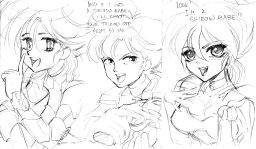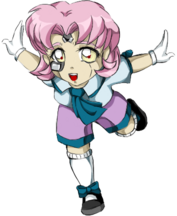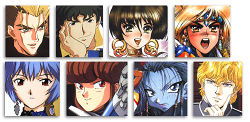Anime and manga: Difference between revisions
m (http->https) |
(general update on where anime/manga are at now, with financial figures that are newer than 2005) |
||
| (3 intermediate revisions by the same user not shown) | |||
| Line 1: | Line 1: | ||
{{Hatnote|For the game's anime opening and ending movies, see [[Intro]] and [[Outro]].}} | {{Hatnote|For the game's anime opening and ending movies, see [[Intro]] and [[Outro]].}} | ||
Apart from the intro and outro sequences, there has been no anime about [[Oni]]. The anime directly mentioned by the game's developers as influences on Oni include [[Ghost in the Shell]] (project lead), [[Bubblegum Crisis]] (concept artist) and Neon Genesis Evangelion (design lead), and these are all very much worth watching. | Apart from the intro and outro sequences, there has been no anime about [[Oni]]. The anime directly mentioned by the game's developers as influences on Oni include [[Ghost in the Shell]] (project lead), [[Bubblegum Crisis]] and [[Trigun]] (concept artist), and [[Neon Genesis Evangelion]] (design lead), and these are all very much worth watching. | ||
There is no official manga about Oni | There is no official manga or anime about Oni besides the opening/ending movies. There is [[Lorraine|art by Lorraine]] though, and the [[:Category:Dark Horse comics|Dark Horse comic books]]. | ||
---- | ---- | ||
| Line 10: | Line 10: | ||
{| | {| | ||
|[[Image:Rina - Chibi Shinatama Final (trans).png|177px]] | |[[Image:Rina - Chibi Shinatama Final (trans).png|177px]] | ||
|'''Anime''' refers to | |'''Anime''' refers to animated works originating in Japan. It is characterized by distinctive characters and backgrounds that visually set it apart from other forms of animation. Storylines may include a variety of fictional or historical characters, events, and settings. Anime is aimed at a broad range of audiences and covers a very wide range of genres. Anime is most frequently broadcast on television/streaming services or sold directly sold on Blu-ray as [[wp:Original video animation|original video animation]]. Console and computer games sometimes also feature segments or scenes that can be considered anime. | ||
'''Manga''' is Japanese | '''Manga''' is Japanese for "comics" or "whimsical images". Manga developed from a mixture of [[wp:Ukiyo-e|ukiyo-e]] and Western styles of drawing, and took its current form shortly after World War II, being known for "exaggerated physical features such as large eyes, big hair and elongated limbs... and dramatically shaped speech bubbles, speed lines and onomatopoeic, exclamatory typography". Manga, apart from covers, is usually published in black and white (but it is common to find introductions to chapters to be in color) and is read from right to left. Financially, digital and physical manga sales in 2024 reached ¥1.1 trillion ($7.7 billion) in Japan and $1.1 billion in the United States. Manga sales have been growing tremendously in the U.S. for over 20 years, and ''quadrupled'' from 2020 to 2024. | ||
Anime | Anime largely descends from the visual tradition of manga. Many anime are adapted directly from manga, often with the collaboration of the original author, though only a small amount of the total manga output gets adapted. Computer games can also give rise to anime, and [[wp:Light novel|light novels]] have risen to become popular source material for anime as well. In such cases, the stories are often compressed and modified to fit the format and appeal to a wider market. Popular anime franchises often include full-length feature films, and some have been adapted into live action films and television programs, and even stage plays. | ||
|} | |} | ||
|} | |} | ||
[[Image:Konoko Variants.jpg|thumb|256px|[[Konoko]] drawn by Lorraine in the styles of three different manga artists (???, [[wp:Kenichi Sonoda|Kenichi Sonoda]], [[wp:Masamune Shirow|Masamune Shirow]]).]] | [[Image:Konoko Variants.jpg|thumb|256px|[[Konoko]] drawn by Lorraine in the styles of three different manga artists (???, [[wp:Kenichi Sonoda|Kenichi Sonoda]], [[wp:Masamune Shirow|Masamune Shirow]]).]] | ||
The characteristic visual style shared by anime and manga can be called "anime" or "manga" depending on the context. Apart from the general characteristic, there is a variety of styles highly characteristic of "schools" or individual artists. There are also categories based on the targeted audience, and general archetypes (e.g., Shina-chan up there is a generic example of the [[:Category: | The characteristic visual style shared by anime and manga can be called "anime" or "manga" depending on the context. Apart from the general characteristic, there is a variety of styles highly characteristic of "schools" or individual artists. There are also categories based on the targeted audience, and general archetypes (e.g., Shina-chan up there is a generic example of the [[:Category:Chibi art|chibi]] style). | ||
The main influence for Oni was the manga/anime franchise Ghost in the Shell, | The main influence for Oni was the manga/anime franchise Ghost in the Shell, so the game's concept artist [[Alex Okita]] came up with some character/environment design, largely anime-inspired, but drawing from not just GitS but other manga/anime that he admired (mentioned in the lede). The intro and outro sequences were based off Okita's storyboards by an actual anime studio called [[wp:Anime International Company|AIC]]. (AIC is mostly now defunct, only occasionally reactivating in order to animate small projects for the Japanese industry.) | ||
Later on, Lorraine Reyes | Later on, Lorraine Reyes joined the team, contributing art in the form of [[:Category:Splashscreens|splashscreens]], [[:Category:Promotional art|promotional art]], etc. and essentially setting a canonical style for Oni's 2D art. The Dark Horse "Oni" comics also borrow heavily (and clumsily) from the look of manga, but Lorraine's work is more skilled, and more authoritative among Oni's [[:Category:Fan art|fan artists]]. Of course, these artists typically diverge from Lorraine's legacy using their own imagination and style. | ||
On another note, Oni's 3D content (character models) is not particularly close to anime/manga guidelines; this is never an easy thing because of how anime and especially manga use "cheats" for depicting characters from different angles which don't align to a single 3-dimensional "truth". | On another note, Oni's 3D content (character models) is not particularly close to anime/manga guidelines; this is never an easy thing because of how anime and especially manga use "cheats" for depicting characters from different angles which don't align to a single 3-dimensional "truth". | ||
| Line 35: | Line 35: | ||
*[[Appleseed]] | *[[Appleseed]] | ||
*[[GUNNM]] a.k.a. Battle Angel Alita | *[[GUNNM]] a.k.a. Battle Angel Alita | ||
*[[ | *Knives Millions from [[Trigun]] (sorta Muro) | ||
*[[Kill Bill]] (killing philosophy) | *[[Kill Bill]] (killing philosophy) | ||
*Full Metal Panic! ([https://web.archive.org/web/20120816063521/http://www.animestocks.com/gallery/category/Full+Metal+Panic!+TSR/Melissa+Mao Melissa Mao]) | *Full Metal Panic! ([https://web.archive.org/web/20120816063521/http://www.animestocks.com/gallery/category/Full+Metal+Panic!+TSR/Melissa+Mao Melissa Mao]) | ||
Latest revision as of 23:59, 12 April 2025
Apart from the intro and outro sequences, there has been no anime about Oni. The anime directly mentioned by the game's developers as influences on Oni include Ghost in the Shell (project lead), Bubblegum Crisis and Trigun (concept artist), and Neon Genesis Evangelion (design lead), and these are all very much worth watching.
There is no official manga or anime about Oni besides the opening/ending movies. There is art by Lorraine though, and the Dark Horse comic books.
- See the "Anime and Manga" portal on Wikipedia for general information about manga and anime. The following introduction was adapted from that portal.
|

The characteristic visual style shared by anime and manga can be called "anime" or "manga" depending on the context. Apart from the general characteristic, there is a variety of styles highly characteristic of "schools" or individual artists. There are also categories based on the targeted audience, and general archetypes (e.g., Shina-chan up there is a generic example of the chibi style).
The main influence for Oni was the manga/anime franchise Ghost in the Shell, so the game's concept artist Alex Okita came up with some character/environment design, largely anime-inspired, but drawing from not just GitS but other manga/anime that he admired (mentioned in the lede). The intro and outro sequences were based off Okita's storyboards by an actual anime studio called AIC. (AIC is mostly now defunct, only occasionally reactivating in order to animate small projects for the Japanese industry.)
Later on, Lorraine Reyes joined the team, contributing art in the form of splashscreens, promotional art, etc. and essentially setting a canonical style for Oni's 2D art. The Dark Horse "Oni" comics also borrow heavily (and clumsily) from the look of manga, but Lorraine's work is more skilled, and more authoritative among Oni's fan artists. Of course, these artists typically diverge from Lorraine's legacy using their own imagination and style.
On another note, Oni's 3D content (character models) is not particularly close to anime/manga guidelines; this is never an easy thing because of how anime and especially manga use "cheats" for depicting characters from different angles which don't align to a single 3-dimensional "truth".
Similar works to Oni
These works can be considered as added value for Oni's universe, and possible influences for an Oni 2 (whatever that is).
- Nausicaä of the Valley of the Wind (many aspects)
- Ergo Proxy (many aspects)
- Ghost in the Shell (duh)
- Appleseed
- GUNNM a.k.a. Battle Angel Alita
- Knives Millions from Trigun (sorta Muro)
- Kill Bill (killing philosophy)
- Full Metal Panic! (Melissa Mao)

